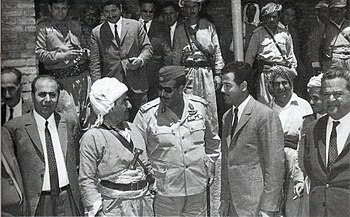쿠웨이트의 시아 이슬람교
Shia Islam in Kuwait시아 이슬람교는 쿠웨이트에서 상당한 소수민족을 이루고 있다.[1][2] 2001년 미 국무부는 시아 쿠웨이트 시민이 30만 명, 쿠웨이트 시민이 82만 명이라고 보고해 시아스가 쿠웨이트 시민 인구의 36.5%를 형성했다.[3] 2002년 미 국무부는 쿠웨이트 시민 인구의 30~40%를 샤이아 쿠웨이트 시민권자가 52만5000명, 쿠웨이트 시민권자가 85만5000명(수니 61%, 시아 39%)에 달했다고 보고했다.[1][1] 2004년에는 시아 쿠웨이트 시민이 30만35만 명, 쿠웨이트 시민이 총 93만3000명이었다.[4] 전략연구소는 그들이 2008년에 인구의 40%를 차지한다고 보고했다.[2]
이라크 정부의 기대와는 달리, 시아 쿠웨이트는 걸프전에서 사담 후세인이 쿠웨이트를 점령하는 동안 현지 무장 저항 운동을 전개하였다.[5][6] 대부분의 쿠웨이트인들은 점령기간 동안 체포, 고문,[7] 처형되었다. 쿠웨이트 저항세력의 사상자 수는 연합군과 서방 인질들의 사상자 수를 훨씬 웃돌았다.[8] 저항은 주로 어떤 형태의 훈련과 감독도 부족한 일반 시민들로 이루어졌다.[8]
시아 쿠웨이트 사회는 많은 분야에서, 특히 비즈니스와 상업에서 눈에 띄는, 유명한 개인들을 많이 배출하여, 그 나라의 전반적인 경제 발전에 크게 기여하고 있다. 쿠웨이트 최초의 여성 장관인 마소우마 알 무바라크는 시아이다. 의회에서 선출된 최초의 여성 중 한 명인 롤라 다쉬티는 쿠웨이트 시아이다.[9] 대부분의 시아 쿠와이티스는 이란의 혈통이다.[10][11][12][13][14][15][16] 시아파의 국회 내 대표성이 낮다.[17] 단체로서의 시아 시민들은 쿠웨이트 주에 통합된다.[18] 쿠웨이트 정부 정책은 종파적으로 시민들을 차별하지 않는다는 주장이 있다.[18]
참고 항목
참조
- ^ a b c "International Religious Freedom Report". US State Department. 2002.
- ^ a b "The Evolution of U. S.-Turkish Relations in a Transatlantic Context" (PDF). Strategic Studies Institute. p. 87.
Shiites comprise 60 percent of the population in Bahrain, 40 percent in Kuwait, 14 percent in Saudi Arabia, and 35 percent in Lebanon.
- ^ "International Religious Freedom Report". US State Department. 2001.
- ^ "International Religious Freedom Report". US State Department. 2004.
- ^ "Saddam's Security Apparatus During the Invasion of Kuwait and the Kuwaiti Resistance". The Journal of Intelligence History. Winter 2003. pp. 74–75.
- ^ "Two ethnicities, three generations: Phonological variation and change in Kuwait" (PDF). Newcastle University. 2010.
- ^ Butenschon, Nils A.; Davis, Uri; Hassassian, Manuel (2000). Citizenship and the State in the Middle East: Approaches and Applications. Nils August Butenschøn, Uri Davis, Manuel Sarkis Hassassian. p. 190. ISBN 9780815628293.
- ^ a b "The Kuwaiti Resistance". Middle East Forum. March 1995.
- ^ "Interview with Dr. Rola Dashti, Member of the Kuwaiti Parliament". Carnegie Endowment for International Peace. 9 March 2010.
- ^ Butenschon, Nils A.; Davis, Uri; Hassassian, Manuel (2000). Citizenship and the State in the Middle East: Approaches and Applications. Nils August Butenschøn, Uri Davis, Manuel Sarkis Hassassian. p. 190. ISBN 9780815628293.
- ^ Binder, Leonard (1999). Ethnic Conflict and International Politics in the Middle East. p. 164. ISBN 9780813016870. Archived from the original (PDF) on 8 December 2013.
Unlike the Shi'a of Saudi Arabia or Bahrain, the Kuwaiti Shi'a mostly are of Persian descent.
- ^ Hertog, Steffen; Luciani, Giacomo; Valeri, Marc (2013). Business Politics in the Middle East. Rivka Azoulay. p. 71. ISBN 9781849042352. Archived from the original on 20 August 2017.
- ^ Ende, Werner; Steinbach, Udo (2002). Islam in the World Today: A Handbook of Politics, Religion, Culture, and Society. Werner Ende, Udo Steinbach. p. 533. ISBN 0801464897. Archived from the original on 31 December 2013.
- ^ Potter, Lawrence G. (June 2014). Sectarian Politics in the Persian Gulf. Lawrence G. Potter. p. 135. ISBN 9780190237967.
- ^ Louër, Laurence (2011). Transnational Shia Politics: Religious and Political Networks in the Gulf. Laurence Louër. p. 47. ISBN 9781849042147.
- ^ Dénes Gazsi. "The Persian Dialects of the Ajam in Kuwait" (PDF). The University of Iowa.
- ^ "Shi'ites lose more than half their seats in Kuwait polls as liberals make gains". 28 Jul 2013.
- ^ a b "Kuwaiti Shia: Government Policies, Societal Cleavages, and the Non-Factor of Iran" (PDF). George Washington University. 2011.


